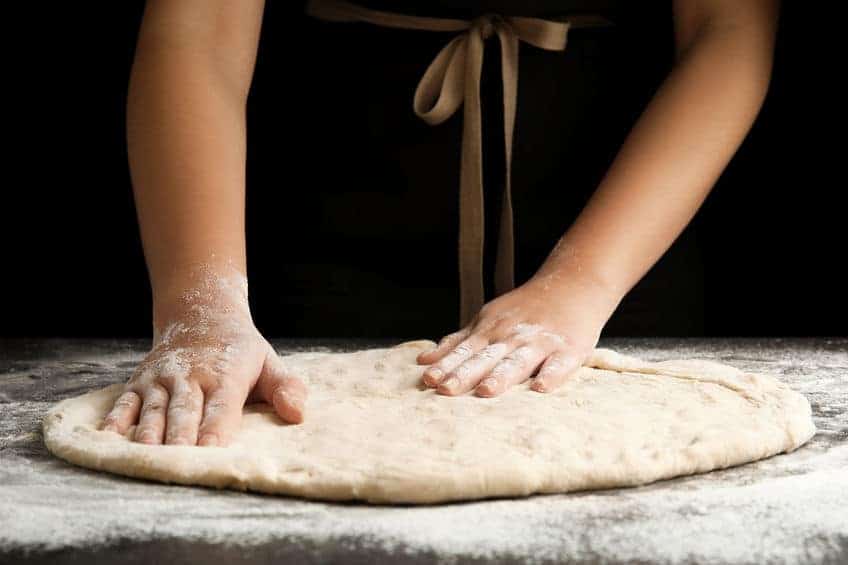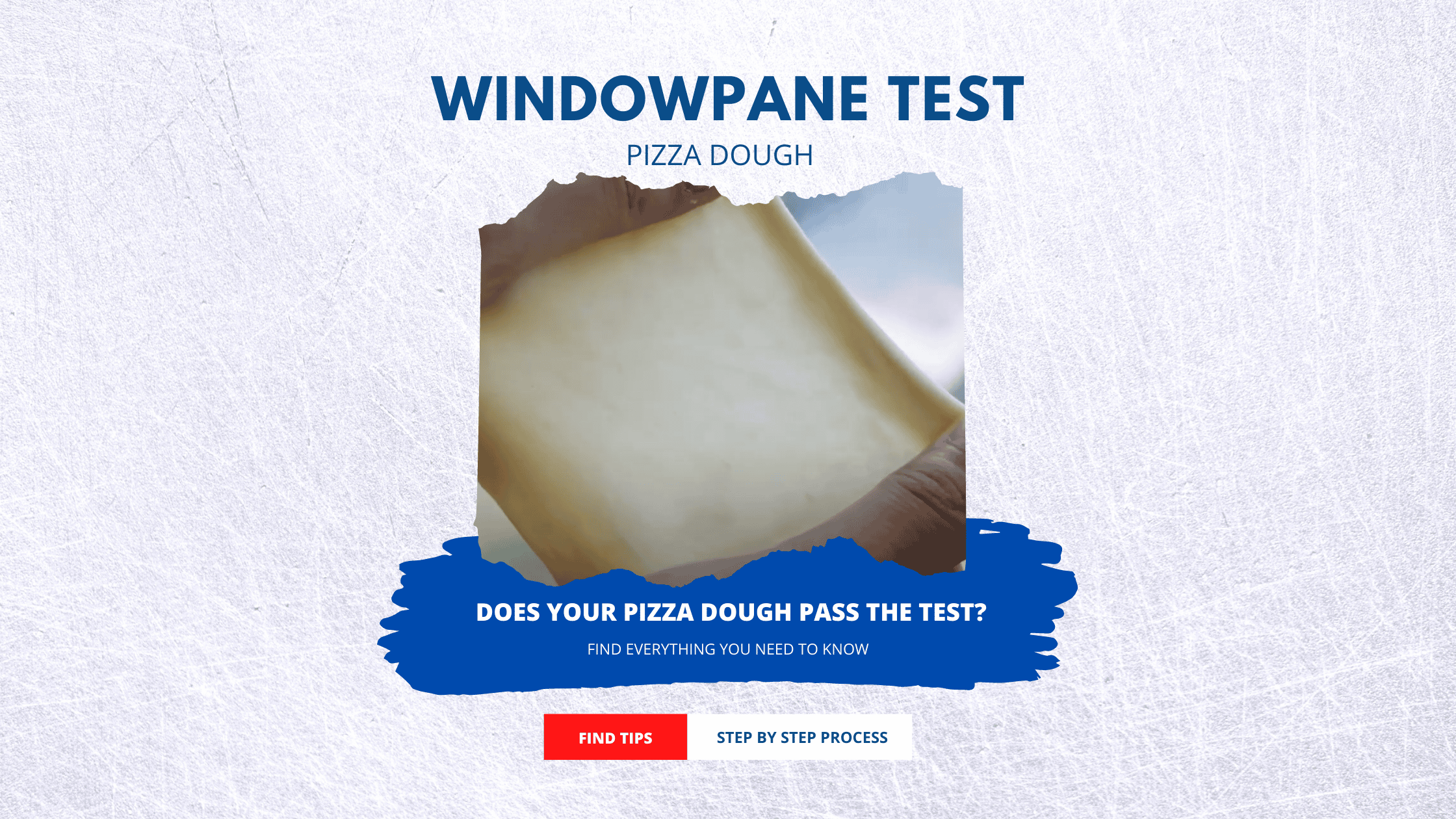So are you having problems because your pizza dough is not stretching?
Learning to fix this problem is simple if you look for the warning signs of what your pizza dough is telling you.
Some recipes could fail you unless you have a homemade pizza dough recipe that always gives you perfect results.
Trying a new pizza dough recipe may be misleading, and some steps are purposely omitted. If you’ve followed all the ingredients and steps and are getting unsatisfactory results, you’ll need to fix it quickly!
So let’s hear what your dough got to say!
Here’s What You Will Find:
Identify Why is Pizza Dough Not Stretching
Like any other situation, to fix something, we need to find out what’s wrong or what caused the problem.
It’s fair enough that pizza dough cannot talk to you, but the overall texture is always a good thing to check.
The kneading process will help you solve a common problem for those not getting the proper pizza dough stretch.
Firstly, assess the situation to find your answer:
Why is my pizza dough not stretching?
There are many reasons your pizza dough may not be stretching, including and not limited to your ingredients, improper dough fermentation, or poor dough handling.

But don’t worry; we will discuss each of these probable causes individually until you answer our questions.
What Makes Pizza Dough Stretch?
The fundamental factor that makes pizza stretch is gluten. Pizza dough that properly develops gluten is filled with gas produced during fermentation. These micro air bubbles allow the dough to stretch without your dough tearing or breaking.
These collapsed air pockets will instantly bond as the glue between the flour, water, and the rest of your ingredients.
For your dough to properly stretch, you need to have the right amount of gluten in your dough because too much gluten causes your dough to be stiff and hard to handle, while low gluten causes your dough to be sticky, fragile with no structure, and susceptible to tearing.
What is Gluten?
Gluten
Gluten is a viscous and elastic substance formed during the mixture of flour, yeast, and water.

Gluten Development
When water and flour mix, it will start to form gluten right away. Kneading the dough will contribute to gluten development.
This gluten development, followed by fermentation, helps stabilize the gluten inside your pizza dough.
With the right amount of gluten formed, the pizza crust has chewiness followed by many levels of crispiness.
We have a complete guide on gluten that gives you everything you need to know. Check our article Demystifying Gluten in Pizza.
Autolyse Method
Most of us have never heard of this method, but it’s the gluten formation in your dough using only water and flour.
You let the dough sit for 1 hour or more to allow the flour to fully absorb the water and start the gluten formation through natural hydration.
After this, you can add the remaining yeast, salt, and olive oil and continue your pizza-making process.
Pizza Dough Extensibility and Elasticity
You cannot stretch this out easily without elastic dough to form your pizza shape. It will tear and likely be a nightmare to shape.
The rule of pizza dough is to have enough elasticity to make the dough thin enough to make any size you like.
When the gluten is activated, it creates both extensible and elastic properties, or the ability to stretch and return to its original shape.
The dough will not form correctly if one of these attributes is stronger.
What is Pizza Dough Extensibility?
Pizza dough extensibility is the dough’s ability to be stretched, extended, or elongated when force, stress, and pressure are applied.
What is Pizza Dough Elasticity?
Pizza dough elasticity is the ability of the dough to regain its original shape after a force, stress, or pressure has been applied.
Simply put, the dough can spring back when it is stretched.
You will need the dough to have a certain amount of extensibility for the dough to be molded into different shapes with little elasticity that will allow the dough to retain its shape.
How to Make Pizza Dough Elastic
To make pizza dough extensible and elastic, combine a high gluten flour and water and let it sit for about 1 hour until it fully absorbs the water.
Initially, this will form a network of unorganized, knotted gluten strings.
Kneading the dough by hand or using a stand mixer will align these strings, creating a dough you can stretch slightly. Just let the dough relax, and time will do the rest.
Later, adding the rest of the ingredients, including the olive oil, will help lubricate the dough, allowing it to stretch easier.
The more gluten develops, the more elastic, stretchy, and strong the dough will be.
Just be careful because mixing too much gluten and water will produce a dough that almost feels like rubber.
Pro Tip
When you are ready to start stretching your pizza dough, cover your hands with a light coat of olive oil and prepare your working surface by adding a combination of flour and cornmeal. This way, you’ll stop the pizza dough from sticking and tearing.
Here’s What You Need to Do if Pizza Dough Not Stretching
- Check Your Ingredients
Ingredients are often mismanaged, and sometimes you might forget to consider how much hydration your brand of flour could be absorbing.
The levels of fineness and milling would throw you off many times, so if you miss the proper quality or amount of ingredients, you might encounter some problems.
Here is what to check:
- It would be best to always use flour with high-protein content of 12% or more. Most of the better quality flour will say on the package listed in the nutrient section.
You can check our article, The Top Pizza Dough Flour That Will Give You the Best Crust.
Find which is the best flour pizza dough and which one we use and recommend.
- Check Your Water Content
Adding water is essential to the overall hydration of your flour. The hydration ratio can range from 65 to 70%. To calculate this ratio, divide the water’s weight by the flour’s weight.
For example, 1000 grams of flour and 650-700 grams of water were added. 650 / 1000 = 65%.
This average hydration level should include the total amount of activated yeast water.
You aren’t a classically trained chef, so you probably don’t know about dough hydration.
Dough hydration is a careful balance of water and flour, but don’t forget that olive oil plays a significant role in your dough’s plasticity.
The fermentation from your yeast further helps give the dough its elasticity.
Pizza Pun
We would like to make a pizza joke, but that’s a bit of a stretch.
- Check the Dough Mixing Process
Make sure your dough is well-mixed. If you are mixing by hand, you should be able to feel if there are any bumps or lumps of unmixed flour.
If you use a stand mixer, mix for up to 10 minutes at low speed and check the consistency.
- Check Your Kneading Process
The importance of kneading cannot be stressed enough in the initial stage of making your dough after its’ first mixed.
Mixing pizza dough seems easy enough, but the kneading will make every bit of difference for the best formation of gluten in your dough.
You knead the pizza dough after the dough is initially mixed and only for a few minutes.
Over-kneading will turn the dough tough.
Not Enough Kneading
Kneading pizza dough will help build up the right amount of gluten. If you don’t knead your dough, it won’t have the strength to spring back or hold its shape after it’s cooked.
When cooked, this under-kneading step will result in a limp dough lacking internal resistance. Kneading your dough for 8 to 10 minutes using a low-speed stand mixer would be best.
- Check Your Dough Hydration
Finely milled flour is excellent for making the perfect pizza crust, but flour also likes to play tricks on you.
Like any finely packed powder, it will love to clump together. Use a whisk in your mixing bowl to ensure your flour hydrates evenly before adding water.
.
If you want to learn more about dough hydration, check our article The Scientifically Proven Formula for Dough Hydration.
What is the Best Hydration for Stretchable Pizza Dough?
For most pizza recipes, the average hydration is between 65-70% water. This ratio is always based on the total gram amount of your flour.
Using 1000 grams of flour will yield 650 to 700 grams of water for hydration.
This ratio should always include your yeast mixture for the best results.
Check Your Dough Temperature
There is a distinction between the actual temperature of the dough and the ambient temperature.
The dough’s temperature, as it begins to prove or rise, affects the rate of fermentation and, in turn, the flavor and texture of the finished crust.
The optimal dough temperature for most pizza doughs is 75 degrees F.
Cold Pizza Dough
Cold pizza dough is harder to stretch; allowing it to come to room temperature before stretching it is best. Despite your yeast mixture being an average of 78-80F degrees, this won’t impact your dough temperature much.
You need a kitchen allowing your pizza dough to ferment at an optimal room temperature for the best results. Or find a spot where this temperature is constant.
What is the Best Temperature for Stretchable Pizza Dough
Any area within your kitchen ranging between 70-80F degrees is excellent for quickly getting your pizza dough to proof.
This means that your dough will become 60-75F degrees from room temperature. You don’t want a spot that is warmer than that to get your dough to ferment.
Check Your Dough Development
You can instantly notice some things in how your dough develops. You can perform the following tests:
Visual Inspection
The first is having a satin to a shiny surface.

Spring Test
This is also known as the “Poke Test.” Poking your dough will tell you if it’s elastic enough but leaves a mark.

Window Pane Test
Stretch a small section to see if it forms a membrane-like window.

Check Your Dough Management
While preparing pizza topping or making pizza sauce, you must continually check on your pizza dough.
This process lets you see how it’s developing and fermenting correctly. After 1 hour, you can start making tests on your dough to see if it’s ready to use.
Check Your Dough Fermentation Process
You can form your risen dough into dough balls for the first 1-1 1/2 hours after the first fermentation.
This method allows you to create smaller-sized servings or to freeze and use them later. Some people like to let for a second proofing to get fluffier chewier crusts.
How Long Should Pizza Dough Rest Before Being Stretched?
Once you see that your dough has fermented in one hour or up to 90 minutes, allow it to rest.
This process should take no more than 30-45 minutes to allow the gluten to have a great taste.
Most pizzerias will let their dough rest for up to 1 or 2 days before being stretched.
Rolling vs. Stretching Pizza Dough
There is a growing debate about the facts of whether or not you should roll out or stretch your pizza dough ball.
Since most of us are unaware of this fun fact, there is a preferred method that makes pizza dough more authentic. It’s also one of the oldest methods that are used. That is, pizza dough should be stretched by hand.
Check our article Rolling vs. Stretching Pizza Dough for more on this subject—everything you Need to Know.
When is the time to stretch your pizza dough?
As soon as you see that your dough is fermented and has good gluten, you can start to stretch your pizza dough.
It also depends on how long you want your dough to form gluten. This can make a big difference when it comes down to overall flavor.
Will Pizza Dough Stay Stretched, or Do You Have to Stretch it Right Before Baking?
Properly hydrated pizza with good gluten formation will stay stretched when your pizza dough is proofed.
However, stretching your dough right before cooking your pizza is best. This method allows your oven enough time to preheat and ample time for adding sauce and toppings.
Pizza Dough Stretching Methods
Here, We’ll give four excellent tips for stretching your pizza dough. Each can be used to your advantage or in combination with your pizza-making ritual.
Which combination you’ll enjoy the most will be your signature in making any great pizza.
Gravity Method
Hanging the dough from your first four fingers and your thumb, allowing it to droop downward slowly, uses gravity.

This method is advantageous since you still allow the dough to stretch without much effort.
You can then rotate the dough to make a rounded pizza shape.
Hand Slap
This is a more aggressive approach to telling your dough who’s the boss, but it works.
Simply slap your hand on the dough surface to flatten it to your liking. You’ll need to angle your hand just right to get the dough to go where you want.

Stretching out with the Back of your Hands
This technique is more or less about using the backside of your knuckles to form the pizza dough.
Start from the center of your dough and work in an outer circle until you reach the outer edge of your pizza. You can also decide to leave a dough ring along the edge likewise.

Pressing and Stretching on a Table or Pan
Instead of using your knuckles, you can also use your four fingers and palm to push the dough outwards on your pastry mat.
On a flour-powdered mat, lift the edge of your dough and stretch lightly until it reaches the pizza size you want, pressing out any unwanted bumps.

Are You Having Trouble Making Pizza Doughballs?
Here’s What You Can Do
We love that you can now buy fresh pizza dough balls straight from New York City. The perfect size for a medium pizza. They will ship frozen, just thaw and make the most wonderful pizza in minutes.
New York Pizza is different. The crust is completely unique. Airy, Crispy, and a taste that can’t be duplicated. Dairy-Free - Soy Free. Pizza Dough is made fresh and frozen only for transportation. All-Natural ingredients - Flour, Water, Olive Oil, Salt, Sugar and Yeast
Price includes Express Shipping. 1 Doughball creates a 12 to 14-inch pie depending on how thick you like the crust.
Complete instructions with each order. Taste the difference New York Water makes!
Pizza Dough Stretching Troubleshooting
Here are some pro tips and tricks that will allow you to get better stretching results when forming your pizza.
You can’t rush good pizza dough depending on how long you’ve let your dough sit. So- here’s what to do if these problems happen.
Pizza Dough Tearing
Dough that will tear indicates that your gluten hasn’t formed yet. It happens more often with one-hour Vegan pizzas, so you must give water and dough time to develop correctly.
For this reason, always allow your dough enough time to ferment additionally.
How Do You Stretch Out Pizza Dough Without Tearing It?
You can always use a method where you push and press the dough instead.
This method will still result in excellent pizza dough that is soft and spongy but a bit more on the chewier side- if you like that. Any method that doesn’t use gravity works excellently.
Here’s What You Need to Do
We think the most challenging part about making pizza is waiting for your dough to ferment and proof to your advantage.
Always count backward 1 to 1 1/2 hours while making pizza dough but keep in mind the temperature of your kitchen. Warmer days will proof your dough faster than colder days.
Pizza Dough Shrinking
Why does your pizza dough bounce back?
When you have any pizza dough that you are fighting to get the dough to stay in its shape, it’s not ready yet.
This result is all due to strong gluten resistance, and it hasn’t had time to relax a bit.
This result can also mean your fermentation hasn’t completely kicked in yet.
How Do You Prevent Pizza Dough from Stretching Back?
Just let your dough rest for 10-15 minutes. As you become more relaxed, so will your pizza dough.
These results will drastically improve if you find a warmer spot in your kitchen that’s nice and warm.
What is the Trick to Stretching Pizza Dough?
The trick of stretching pizza dough is to have proper elasticity. You should get a pizza dough that will stretch easily using high gluten-content flour, adequate hydration, and sound mixing and fermentation.
Tips on How to Stretch Pizza Dough
Be creative with your stretching technique, and be patient and confident in your first or second attempt.
Plenty of tutorial videos on forming and stretching pizza dough show you where to put your hands. But you will always know that proofed pizza dough forms easier when it’s given time to relax.
In the meantime, enjoy this video provided by Ooni.
This video is brought to you by Ooni
The Last Slice
We hope you know what to do if the pizza dough is not stretching. For additional information, you can visit our learn section, and if you have any questions, you may contact us.
Additional Resources on Pizza Dough

How to Mix Pizza Dough
the PROs
Do you want to learn how to mix pizza dough? Pizza dough is a staple in most households, but it …

Best Water for Pizza Dough: Temperature, Quality, and Hydration
the PROs
In this article, we are going to dive deep into the mysterious ways of water. In conjunction with flour, yeast, and salt, it can make the most spectacular pizza dough.

Salt in Pizza Dough: The Secret to a Perfectly Seasoned Crust
the PROs
Making homemade pizza is not complicated; see how with just a few ingredients like flour, water, yeast, and salt you can do wonders. In this article, we will discuss the role of salt in homemade pizza and discover four (4) basic rules applicable to salt, that are easy to remember that will make you a better homemade pizza baker.

Poke Test Demystified: Master the Technique for Perfect Pizza Every Time
the PROs
Are you tired of ending up with a pizza crust that’s either too thick or still raw in some parts, …

How to Stretch Pizza Dough Like a PRO: Tips and Tricks to Elevate Your Homemade Pizza Game!
the PROs
So you’ve decided to make your pizza but are unsure how to stretch pizza dough to perfection. Well, fear not! …

How to Proof Pizza Dough Fast
the PROs
How to Proof Pizza Dough Fast Behind every tasty pizza dough is a secret. Secrets behind its fantastic flavor and …

Windowpane Test: (Tips, How-to, and Everything You Need to Know)
the PROs
Pizza Dough Windowpane Test Kneading the dough is probably one of the most complex parts of baking a pizza. You …

Can You Freeze Pizza Dough? (Everything You Need to Know)
the PROs
How to Freeze Pizza Dough Are you wondering how to freeze pizza dough? Most of us know that putting things …

What is Pizza Dough? Here’s What You Need to Know and How to Make It
the PROs
Pretty much everyone likes pizza. But when you first start making pizza at home, you can feel a little overwhelmed. …
Enjoy!
Not a PRO? Not a Problem!
Take a pizza class to bring your pizza skills to the next level,
so you can be a PRO!
Related Posts

Costco Pizza Delivery: Find How You Can Get It Now!
the PROs
People go to Costco’s food court for many different reasons, but the cheesy slice of pizza they serve is among …

Pizza for Beginners: Don’t Buy Pizza, Make It! Here’s How to Get Started!
the PROs
You have this idea that you want to make pizza at home as opposed to ordering it, but where do you start? Don’t worry! Here you will find answers and directions to all your questions.

Pizza Toppings Under Cheese or Over Cheese? [Why the Order Matters]
the PROs
Is Pizza Cheese on Top or Bottom? Hey pizza lovers, are you wondering if you should layer pizza toppings under …
Newsletter
Subscribe to our Recipe of the Week newsletter and receive our partners’ latest recipes, tips, and discount offers.
Keep in Touch!


